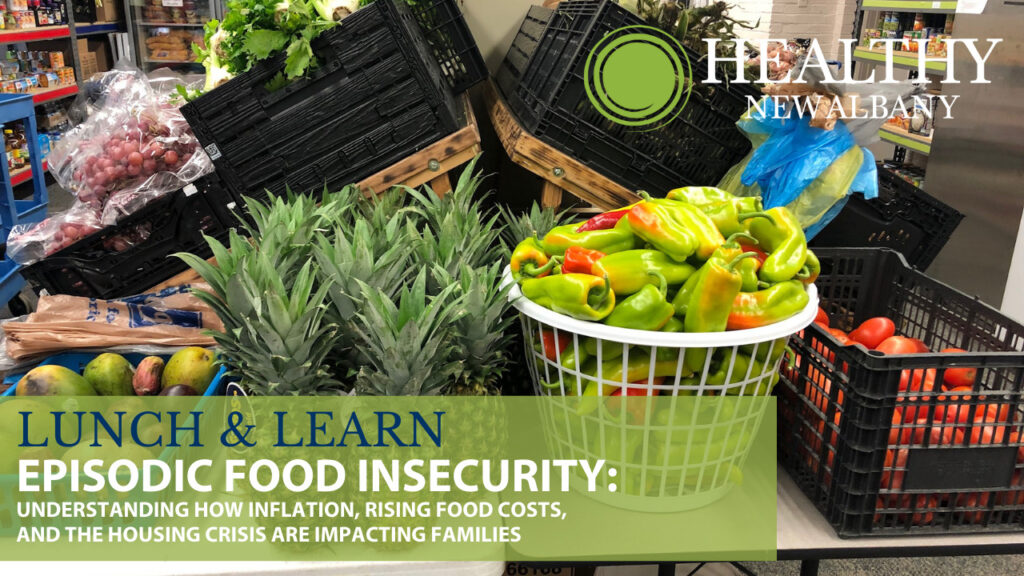
Lunch and Learn Healthy New Albany | Episodic Food Insecurity: Understanding How Inflation, Rising Food Costs, and the Housing Crisis are Impacting Families | September 2022
Lunch and Learn Healthy New Albany. On Friday, September 16th, Healthy New Albany and our attendees heard from three panelists about episodic food insecurity. We discussed how understanding how iInflation, rising food costs, and the housing crisis are impacting families. Healthy New Albany’s Executive Director, Angela Douglas talked with Glennon Sweeney the senior research associate at the Kirwan Institute for the Study of Race and Ethnicity, Jennifer Wilcoxon the Director of the Healthy New Albany Food Pantry, and Angie Ojeda-Kreiman the English Language Learner (ELL) coordinator at the Healthy New Albany Food Pantry.
We’ve all noticed the recent trends: skyrocketing prices on food, inflation, higher gas prices, and the shortage of affordable housing. What we may not fully understand is how all of these issues are converging to create episodic food insecurity and how living “paycheck-to-paycheck” can affect families.
The Lunch & Learn took place at the Healthy New Albany Food Pantry to allow attendees to gain a better understanding of how we’re addressing food insecurity right here in our own community. Also, attendees took tours of the food pantry before the presentation began.
Key Takeaways
The mission of the Healthy New Albany Food Pantry is to eliminate food insecurity within the NAPLS District by connecting our neighbors in need with food and other critical resources.
In New Albany, there are approximately 500 students (10% of school population) whose families qualify for the federal free & reduced lunch program.
Statistics tell us that food insecurity is moving to the suburbs at a faster rate than urban areas, particularly in Ohio.
The annual State of Poverty report commissioned by the Ohio Association of Community Action Agencies state that Columbus has the state’s greatest concentration of suburban poor. Their report notes that 12% of suburban Columbus residents live in poverty.
There has been an 82% increase in New Albany neighbors seeking services. Housing is usually the first expense that people try to meet. So, when it gets tight, food or medical care is what gets cut.
Recognize myths of multi family housing such as, higher crime rates, burden on the schools, & lower property values, as myths. You can build affordable housing that is dense and also meet the character of the community.
If we do not address the housing crisis of affordable housing, those people who are experiencing episodic food insecurity will start experiencing chronic food insecurity.
How Is Affordability Defined?
- The Median Household Income in Franklin County is $62,352 In the Columbus Metropolitan Statistical Area: $66,715
- In the New Albany-Plain Local School District: $131,181
- In the city of New Albany: $200,580
- Intel workers average salaries are expected to be $135,000
Healthy New Albany Food Pantry Stats:
In the past year we have provided 220,000 meals to over 1,000 individuals from nearly 3oo households. 50% of them were new clients to the pantry.
82% increase in the number of New Albany neighbors served compared to 2019.
Since 2020 our food costs have quadrupled as prices rise and staples that were once provided to us for free. For example, milk, we now have to buy for full price at retail.
Resources
- Book: Freedom to Discriminate: How Realtors Conspired to Segregate Housing and Divide America by Gene Slater
- Book: Neighborhood Defenders by Katherine Levine Einstein, David M. Glick, Maxwell Palmer
- Event: Building Inclusive Communities | Worthington, OH – Official Website
- Healthy New Albany Food Pantry
- Donate to the Healthy New Albany Food Pantry
Thank you to our sponsor Bubbly Hall
Lunch for this Lunch & Learn was provided by The Pit. Bubbly Hall is a new project underway on Central College Road. Bubbly Hall is a food hall that will be opening soon with 15,000 square feet of retail, food, and event space. Thank you Bubbly Hall for your support of Healthy New Albany and our community.

